Quantifying the Training and Match-Play External and Internal Load of Elite Gaelic Football Players
Abstract
1. Introduction
2. Materials and Methods
2.1. Approach to Problem
2.2. Participants
2.3. Training Load Analysis
2.4. Statistical Analysis
3. Results
3.1. Analysis of Internal Load by Phase
3.2. Analysis of External Load by Phase
3.3. Positional Analysis of External Load by Phase
3.4. Match and Non-Match Weeks across Position and External Load
4. Discussion
5. Conclusions
Author Contributions
Funding
Institutional Review Board Statement
Informed Consent Statement
Acknowledgments
Conflicts of Interest
References
- Malone, S.; Roe, M.; Doran, D.A.; Gabbett, T.J.; Collins, K.D. Protection Against Spikes in Workload with Aerobic Fitness and Playing Experience: The Role of the Acute:Chronic Workload Ratio on Injury Risk in Elite Gaelic Football. Int. J. Sports Physiol. Perform. 2017, 12, 393–401. [Google Scholar] [CrossRef] [PubMed]
- Cullen, B.D.; McCarren, A.L.; Malone, S. Ecological validity of self-reported wellness measures to assess pre-training and pre-competition preparedness within elite Gaelic football. Sport Sci. Health 2020, 1–10. [Google Scholar] [CrossRef]
- Malone, S.; Solan, B.; Hughes, B.; Collins, K. Duration specific Running performance in Elite Gaelic Football. J. Strength Cond. Res. 2017. [Google Scholar] [CrossRef] [PubMed]
- Malone, S.; Solan, B.; Collins, K. The Running Performance Profile of Elite Gaelic Football Match-Play. J. Strength Cond. Res. 2017, 31, 30–36. [Google Scholar] [CrossRef]
- Malone, S.; Solan, B.; Collins, K.D.; Doran, D.A. Positional Match Running Performance in Elite Gaelic Football. J. Strength Cond. Res. 2016, 30, 2292–2298. [Google Scholar] [CrossRef]
- Mangan, S.; Malone, S.; Ryan, M.; McGahan, J.; O’Neill, C.; Burns, C.; Warne, J.; Martin, D.; Collins, K. The influence of match outcome on running performance in elite Gaelic football. Sci. Med. Footb. 2017, 1, 272–279. [Google Scholar] [CrossRef]
- Mangan, S.; Malone, S.; Ryan, M.; Mc Gahan, J.; Warne, J.; Martin, D.; O’Neill, C.; Burns, C.; Collins, K. Influence of Team Rating on Running Performance in Elite Gaelic Football. J. Strength Cond. Res. 2018, 32, 2584–2591. [Google Scholar] [CrossRef]
- Ritchie, D.; Hopkins, W.G.; Buchheit, M.; Cordy, J.; Bartlett, J.D. Quantification of Training and Competition Load Across a Season in an Elite Australian Football Club. Int. J. Sports Physiol. Perform. 2016, 11, 474–479. [Google Scholar] [CrossRef]
- Burgess, D.; Drust, B. Developing a physiology-based sports science support strategy in the professional game. In Science and Soccer: Developing Elite Performers; Williams, M., Ed.; Routledge: Oxon, UK, 2012; pp. 372–389. [Google Scholar]
- Impellizzeri, F.M.; Rampinini, E.; Marcora, S.M. Physiological assessment of aerobic training in soccer. J. Sports Sci. 2005, 23, 583–592. [Google Scholar] [CrossRef]
- Malone, J.J.; Di Michele, R.; Morgans, R.; Burgess, D.; Morton, J.P.; Drust, B. Seasonal Training-Load Quantification in Elite English Premier League Soccer Players. Int. J. Sports Physiol. Perform. 2015, 10, 489–497. [Google Scholar] [CrossRef]
- Buchheit, M.; Allen, A.; Poon, T.K.; Modonutti, M.; Gregson, W.; Di Salvo, V. Integrating different tracking systems in football: Multiple camera semi-automatic system, local position measurement and GPS technologies. J. Sports Sci. 2014, 32, 1844–1857. [Google Scholar] [CrossRef] [PubMed]
- Malone, S.; Shovlin, A.; Collins, K.; McRobert, A.; Doran, D. Is the metabolic power paradigm ecologically valid within elite Gaelic football? Sport Sci. Health 2021. [Google Scholar] [CrossRef]
- Ryan, M.; Malone, S.; Collins, K. Acceleration Profile of Elite Gaelic Football Match Play. J. Strength Cond. Res. 2018, 32, 812–820. [Google Scholar] [CrossRef]
- Malone, S.; Hughes, B.; Roe, M.; Mangan, S.; Collins, K. Factors that Influence Session-Rating of Perceived Exertion in Elite Gaelic Football. J. Strength Cond. Res. 2020, 34, 1176–1183. [Google Scholar] [CrossRef]
- Gallo, T.; Cormack, S.; Gabbett, T.; Williams, M.; Lorenzen, C. Characteristics impacting on session rating of perceived exertion training load in Australian footballers. J. Sports Sci. 2014, 33, 467–475. [Google Scholar] [CrossRef]
- McGahan, J.; Burns, C.; Lacey, S.; Gabbett, T.; O’Neill, C. Relationship between load and readiness to train in a Gaelic football pre-competition training camp. Aust. J. Strength Cond. 2019, 27, 28–35. [Google Scholar]
- Akubat, I.; Patel, E.; Barrett, S.; Abt, G. Methods of monitoring the training and match load and their relationship to changes in fitness in professional youth soccer players. J. Sports Sci. 2012, 30, 1473–1480. [Google Scholar] [CrossRef]
- Banister, E.W. Modelling elite athlete performance. In Physiological Testing of Elite Athletes; Green, H.J., McDougall, J.D., Wagner, H.A., Eds.; Human Kinetics: Champaign, IL, USA, 1991; pp. 403–424. [Google Scholar]
- Bompa, T.O.; Haff, G.G. Periodization: Theory and Methodology of Training, 5th ed.; Human Kinetics: Champaign, IL, USA, 2009. [Google Scholar]
- Foster, C. Monitoring training in athletes with reference to overtraining syndrome. Med. Sci. Sports Exerc. 1998, 30, 1164–1168. [Google Scholar] [CrossRef]
- Maddison, R.; Ni Mhurchu, C. Global positioning system: A new opportunity in physical activity measurement. Int. J. Behav. Nutr. Phys. Act. 2009, 6, 73. [Google Scholar] [CrossRef] [PubMed]
- Hopkins, W.G. A spreadsheet for deriving a confidence interval, mechanistic inference, and clinical inference from a p-value. Sports Sci. 2007, 11, 16–20. [Google Scholar]
- Rogalski, B.; Dawson, B.; Heasman, J.; Gabbett, T.J. Training and game loads and injury risk in elite Australian footballers. J. Sci. Med. Sport 2013, 16, 499–503. [Google Scholar] [CrossRef] [PubMed]
- Reilly, T.; Collins, K. Science and the Gaelic sports: Gaelic football and hurling. Eur. J. Sport Sci. 2008, 8, 231–240. [Google Scholar] [CrossRef]
- Gabbett, T.J. The training-injury prevention paradox: Should athletes be training smarter and harder? Br. J. Sports Med. 2016, 50, 273–280. [Google Scholar] [CrossRef] [PubMed]
- Gabbett, T.J. How Much? How Fast? How Soon? Three Simple Concepts for Progressing Training Loads to Minimize Injury Risk and Enhance Performance. J. Orthop. Sports Phys. Ther. 2020, 50, 570–573. [Google Scholar] [CrossRef]
- Slattery, K.M.; Wallace, L.K.; Bentley, D.J.; Coutts, A.J. Effect of training load on simulated tram sport match performance. Appl. Physiol. Nutr. Metab. 2012, 37, 315–322. [Google Scholar] [CrossRef] [PubMed]
- Malone, S.; Hughes, B.; Collins, K.; Akubat, I. Methods of Monitoring Training Load and Their Association With Changes Across Fitness Measures in Hurling Players. J. Strength Cond. Res. 2020, 34, 225–234. [Google Scholar] [CrossRef]
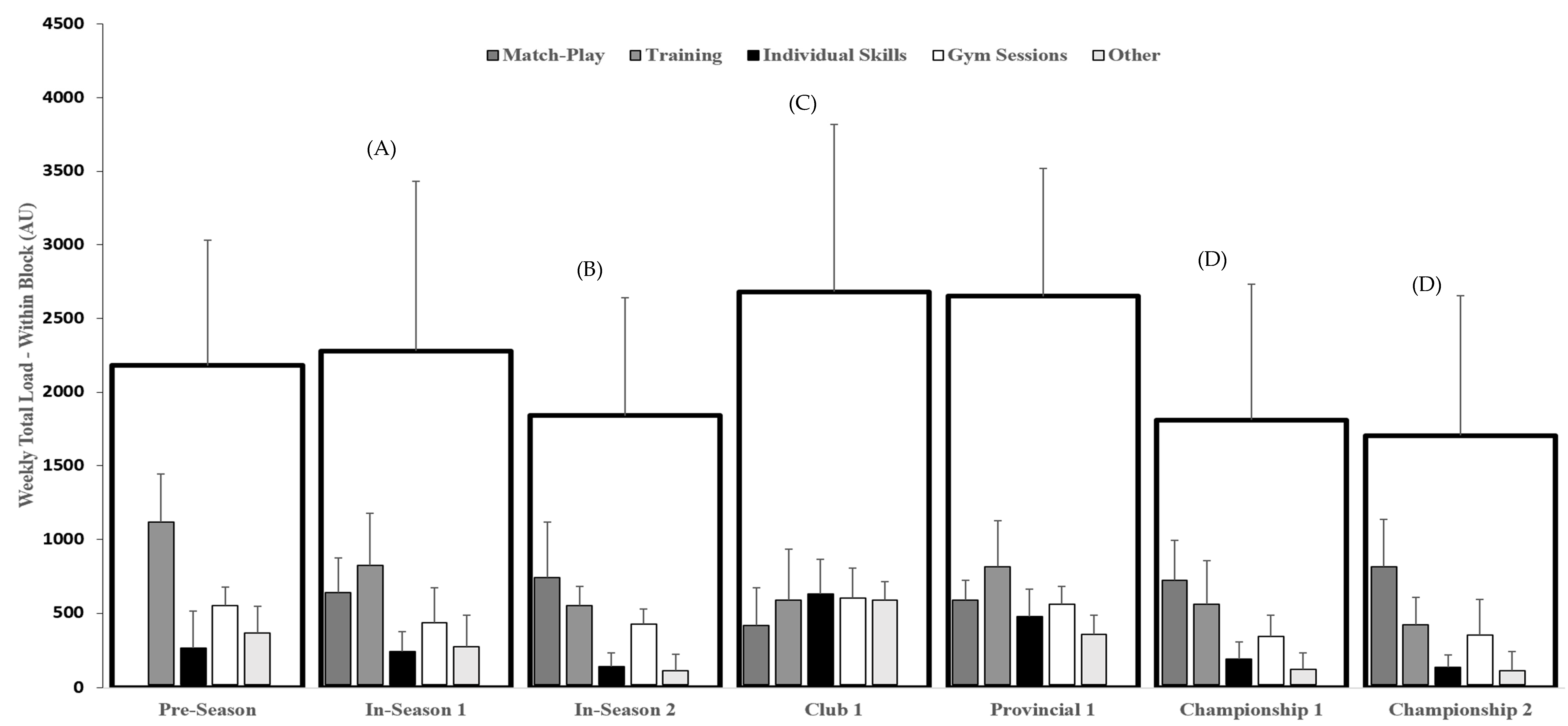
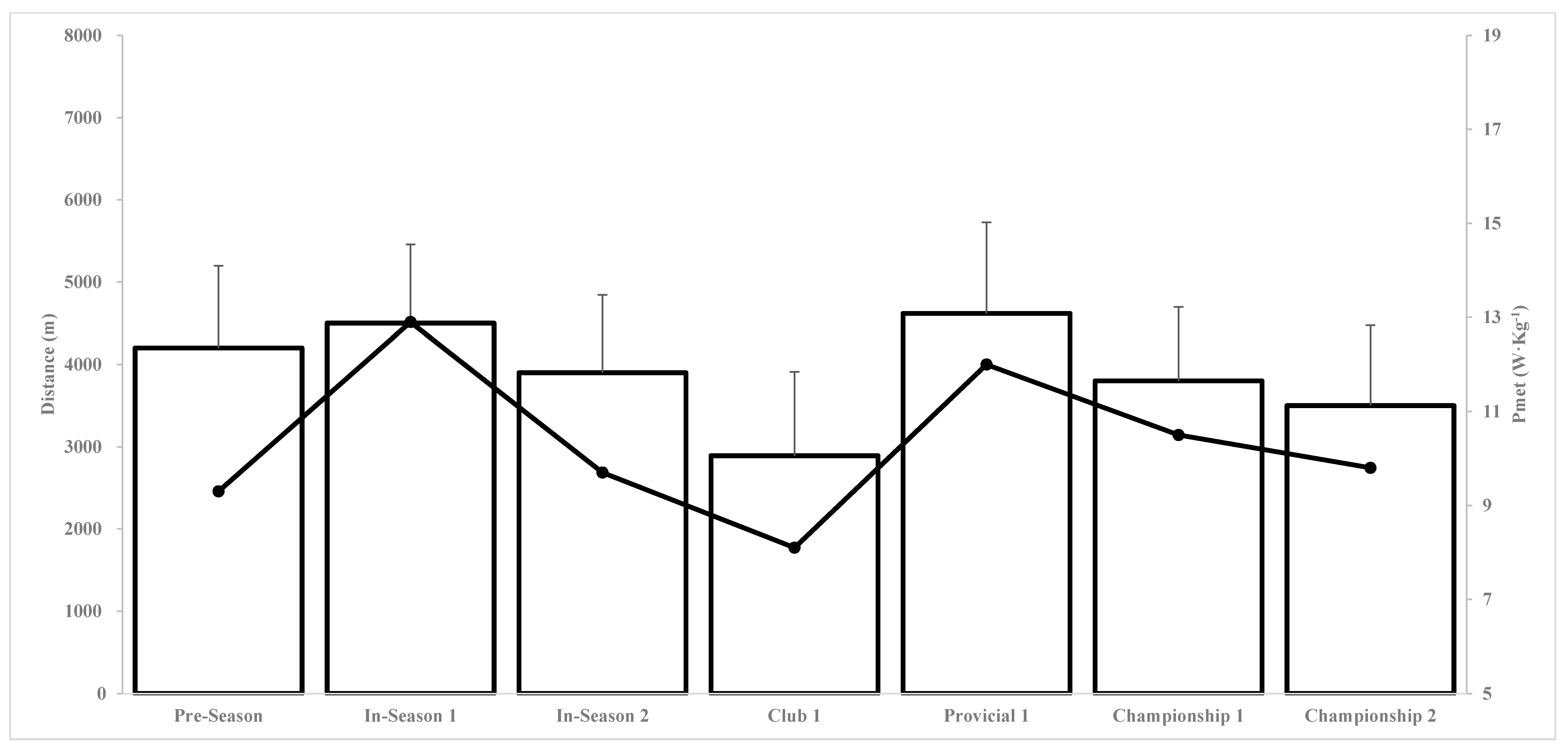
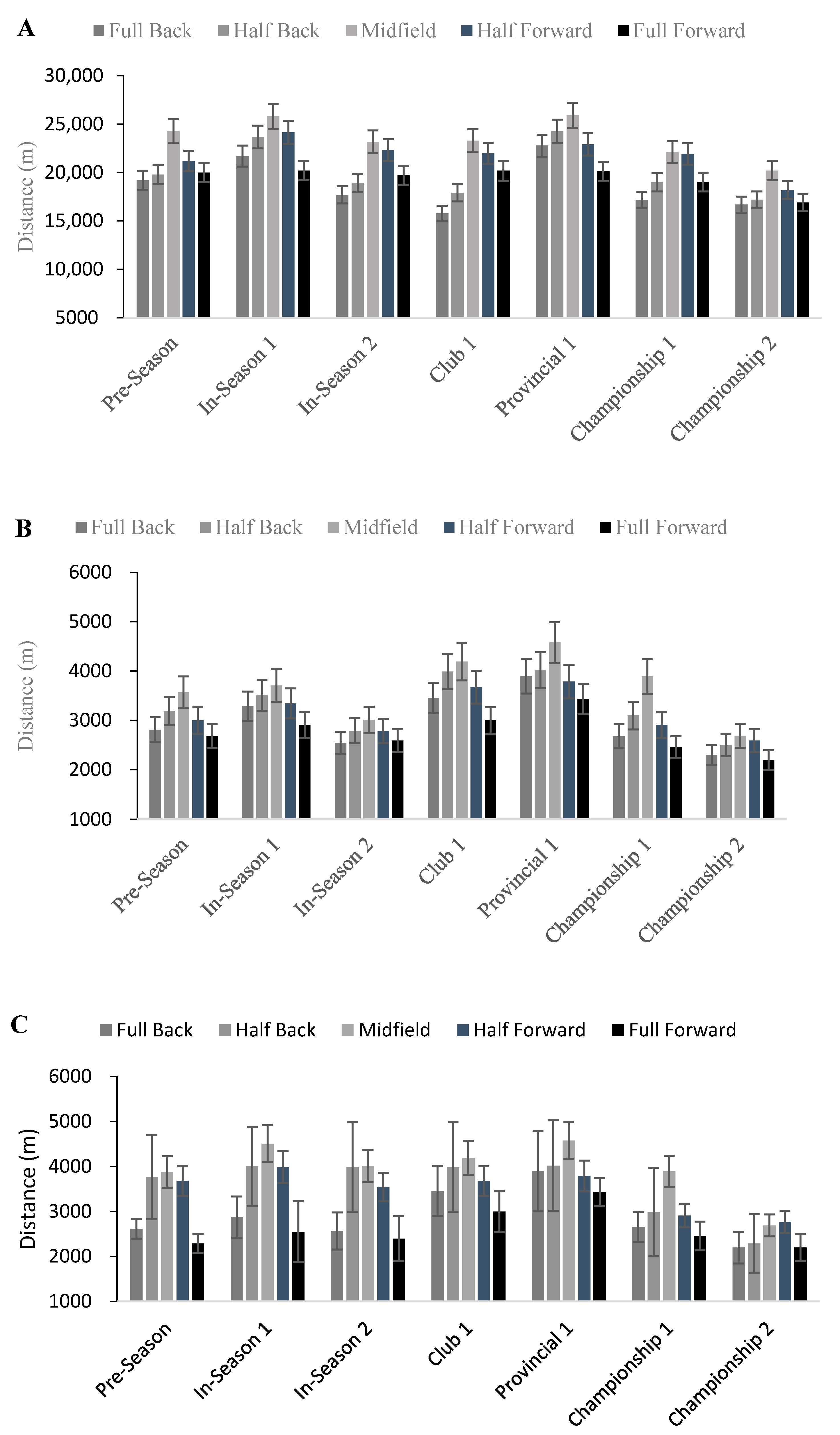
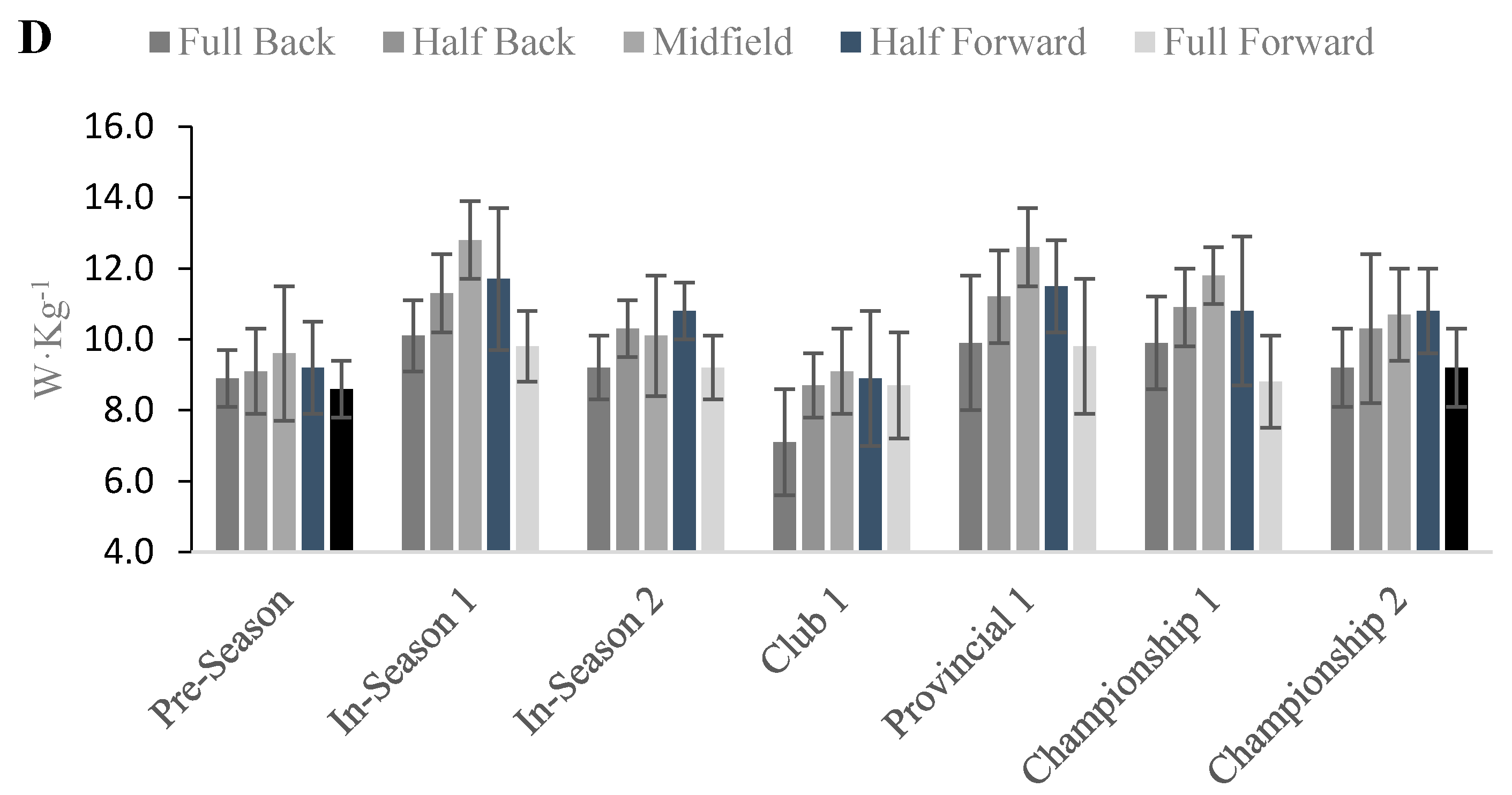
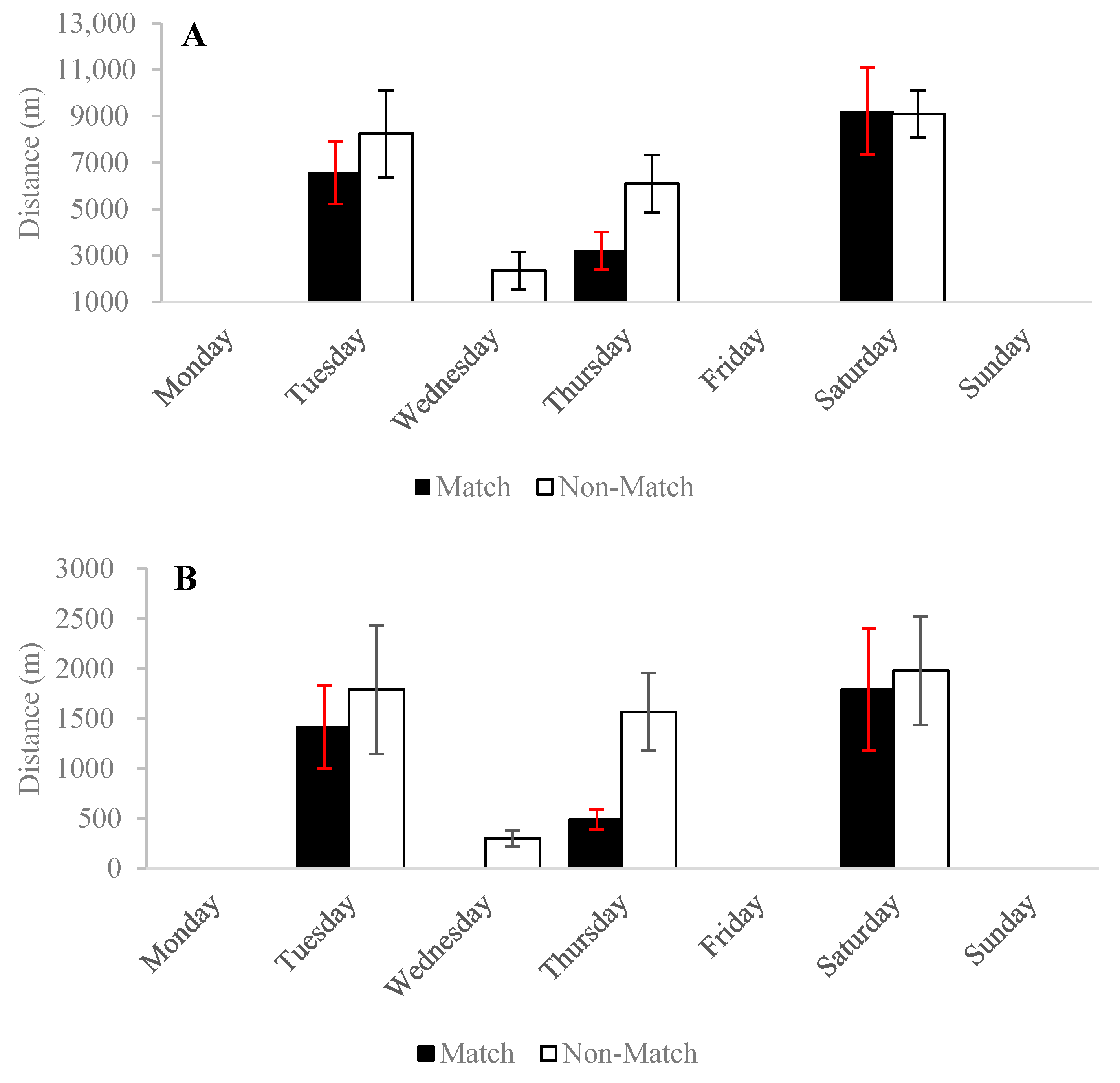
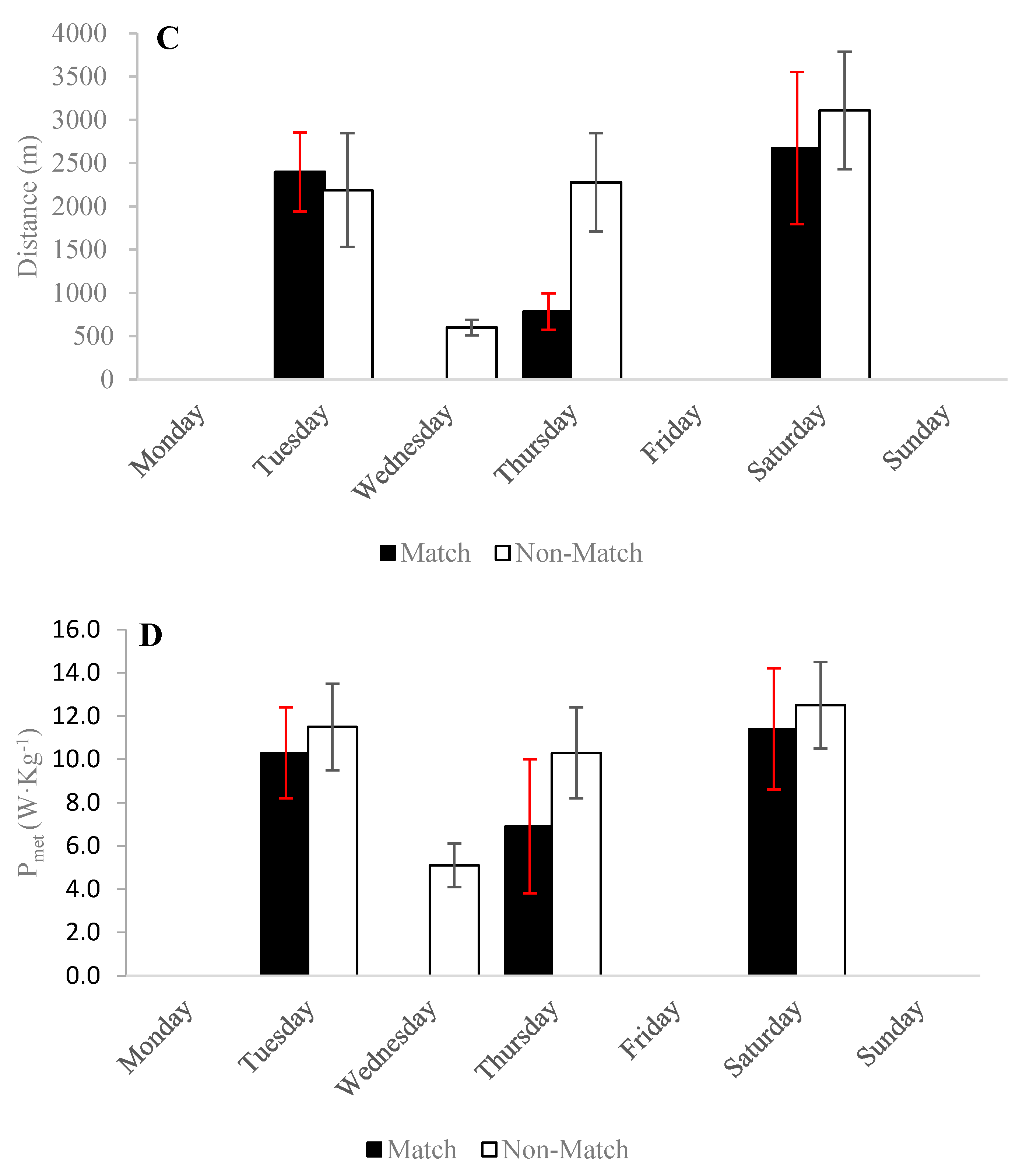
| Phase | Total Load | Match-Play | Training | Individual Skills | Gym Sessions | Other |
|---|---|---|---|---|---|---|
| Pre-season | 2180 ± 850 b | - | 1080 ± 321 a | 240 ± 244 | 520 ± 123 | 340 ± 176 b |
| In-Season 1 | 2280 ± 1150 b | 610 ± 230 | 790 ± 350 b | 220 ± 130 | 410 ± 230 | 250 ± 210 b |
| In-Season 2 | 1840 ± 800 | 710 ± 370a | 520 ± 130 | 120 ± 90 | 400 ± 100 | 90 ± 110 |
| Club 1 | 2680 ± 1140 a | 390 ± 250 | 560 ± 340 | 600 ± 230 a | 570 ± 200 | 560 ± 120 a |
| Provincial 1 | 2650 ± 870 a | 560 ± 130 | 780 ± 310 b | 450 ± 180 b | 530 ± 120 | 330 ± 130 b |
| Championship 1 | 1810 ± 920 | 690 ± 270a | 530 ± 290 | 170 ± 110 | 320 ± 140 a | 100 ± 110 |
| Championship 2 | 1705 ± 950 | 780 ± 320a | 395 ± 180 | 115 ± 80 | 325 ± 240 a | 90 ± 130 |
| Phase | Duration (min) | Total Distance (m) | High Speed Distance (m) | Very High-Speed Distance (m) | Sprint Distance (m) | Accelerations (n) | ||||||
|---|---|---|---|---|---|---|---|---|---|---|---|---|
| Training | Match-Play | Training | Match-Play | Training | Match-Play | Training | Match-Play | Training | Match-Play | Training | Match-Play | |
| Pre-season | 155 ± 50 a | - | 22,369 ± 2300 a | - | 2813 ± 890 a | - | 1812 ± 876 a | - | 619 ± 418 a | - | 181 ± 98 | - |
| In-Season 1 | 120 ± 35 | 72 ± 5 | 12,546 ± 3456 | 8999 ± 1098 | 1687 ± 810 | 1513 ± 786 | 1300 ± 867 | 796 ± 509 | 489 ± 355 bc | 371 ± 317 | 191 ± 77 a | 171 ± 90 |
| In-Season 2 | 110 ± 35 | 72 ± 5 | 11,354 ± 2980 | 9321 ± 1287 b | 1403 ± 934 | 1797 ± 874 | 1270 ± 987 | 834 ± 528 | 479 ± 213 bc | 401 ± 365 | 178 ± 91 | 181 ± 93 |
| Club 1 | 150 ± 30 a | 65 ± 3 a | 13,877 ± 2877 | 8679 ± 1321 | 1787 ± 879 | 1498 ± 599 | 1501 ± 766 b | 799 ± 578 | 410 ± 341 c | 290 ± 189 c | 166 ± 87 | 165 ± 77 a |
| Provincial 1 | 150 ± 35 a | 75 ± 6 | 14,356 ± 3076 b | 9321 ± 1087 | 2002 ± 913 b | 1698 ± 531 | 1400 ± 789 b | 845 ± 678 b | 345 ± 244 c | 421 ± 231 | 171 ± 89 | 181 ± 87 |
| Championship 1 | 95 ± 40 | 77 ± 4 | 10,356 ± 3211c | 9412 ± 1098 b | 1635 ± 956 | 1865 ± 987 | 1398 ± 979 | 978 ± 567 a | 123 ± 101 | 461 ± 321 | 181 ± 88 | 185 ± 88 |
| Championship 2 | 90 ± 36 | 74 ± 7 | 8876 ± 1297c | 9541 ± 1256 a | 1514 ± 866 | 1986 ± 654 a | 1100 ± 992 | 986 ± 766 a | 108 ± 99 | 489 ± 298 a | 177 ± 64 | 183 ± 84 |
Publisher’s Note: MDPI stays neutral with regard to jurisdictional claims in published maps and institutional affiliations. |
© 2021 by the authors. Licensee MDPI, Basel, Switzerland. This article is an open access article distributed under the terms and conditions of the Creative Commons Attribution (CC BY) license (http://creativecommons.org/licenses/by/4.0/).
Share and Cite
Malone, S.; Collins, K.; McRobert, A.; Doran, D. Quantifying the Training and Match-Play External and Internal Load of Elite Gaelic Football Players. Appl. Sci. 2021, 11, 1756. https://doi.org/10.3390/app11041756
Malone S, Collins K, McRobert A, Doran D. Quantifying the Training and Match-Play External and Internal Load of Elite Gaelic Football Players. Applied Sciences. 2021; 11(4):1756. https://doi.org/10.3390/app11041756
Chicago/Turabian StyleMalone, Shane, Kieran Collins, Allistair McRobert, and Dominic Doran. 2021. "Quantifying the Training and Match-Play External and Internal Load of Elite Gaelic Football Players" Applied Sciences 11, no. 4: 1756. https://doi.org/10.3390/app11041756
APA StyleMalone, S., Collins, K., McRobert, A., & Doran, D. (2021). Quantifying the Training and Match-Play External and Internal Load of Elite Gaelic Football Players. Applied Sciences, 11(4), 1756. https://doi.org/10.3390/app11041756







